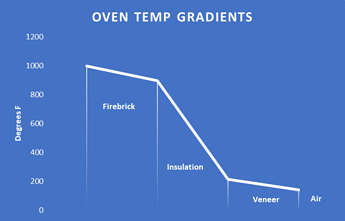Hello everyone. First time poster. I am building my base and am concerned about the heat transfer from the firebrick to the base, the sides, or the top of the oven causing the materials in contact with the fire brick to crack, explode, or fall apart. The fire brick is 1 1/4" thick. I may use dense concrete products in all cases or something else underneath the bricks, outside walls, and ceiling. Should I be concerned or will the heat transfer from the fire brick to the bottom and outside decorative parts of the oven be tolerable/minimal?
Hi, Welcome to the forum.
Being the uber nerd that I am I actually looked at this a while ago. So…
After a look day of heating up the oven in full sun I measure the internal brick temp to be 1000 degrees and the surface temp of the veneer to be 140 degrees. My oven is made to brickwood specification with the firebricks on edge (3.5"), 3" of insulation and 1.5" of veneer. The thermal transfer coefficients are easily found online as are the steady state heat transfer equations which through the power of excel gives this graph:
Take-aways:
- You need insulation. To get the same temp drop as 3" insulation you would need 9" of veneer or 30" of firebrick.
- Without insulation the outside shell temp would be a lot higher and/or the inside temp would be lower because you are taking heat out of the system faster.
Bottom line is I’d be concerned if you have no insulation at all. It would probably be too hot to touch and you might have trouble getting the oven hot enough.
I didn’t look at the hearth but, with the specified insulation, it doesn’t get too warm at all.
Great response and thank you. What about the bottom of the oven where the logs are resting and burning? There is no insulation or mortar that the brick is sitting on. Could that degrade or affect the concrete below it? Would it be a good idea to put insulation below the firebrick on the bottom?
Hi Cameron, and welcome to the BrickWood forum!
First ^^^^ what @kgondoly Ken said. My Mattone Barile Grande oven is built to BrickWood specs with a double layer of insulation between the firebrick and the outer stucco shell. Pretty much the only warmth on the stucco comes from solar radiation, even after many hours of “soaking” from the inside.
The brick frame does not appear to get even a little warm.
If you are building the BrickWood design for base and hearth, look more closely. You do in fact have a layer of insulation under the hearth firebrick. It is built like a layer cake, with concrete on the bottom, a layer of either insulating castable concrete or Portland cement/Perlite, sand for leveling, and the firebrick on top.
The primary reason for the insulating layer is to provide a thermal break between hot firebrick and cold concrete…otherwise the concrete would act like a heat sink and draw thermal energy away from the firebrick.
I suppose a secondary reason would be to protect the concrete from the kind of degradation you are describing. In practice I doubt that would be significant.
I was not sure from your post whether you are proposing to skip insulation in either the shell or the base. I’ve seen photos of ovens where that was done. It saves maybe $300 in construction costs, until (as you say) the outer shell cracks, explodes, or falls apart. Sometimes the exterior of the oven can be rebuilt after an event like that, but it’s better to do it correctly in the first place.
Finally, I can assure you that one of the BrickWood designs, built according to the instructions, will retain heat where it’s supposed to be, and insulate from heat where it’s not supposed to be. @BrickWood made these designs with DIY’ers like you and me in mind, and included a large margin of safety in the specs.
Good luck with your build, Cameron; I’d love to see your progress in photos!
Wow. Great response. I don’t think I noticed that in the instructions. Once I order and start building, I will share the experience and photos. Thank you.
RedDevilJeep,
Follow the Brickwwod plans and you will have a hard time going wrong. I would have concerns with the 1 1/4 wide fire brick.
I used standard 2 1/4 x 4 1/2 x 8 7/8 fire brick with 3 inch of insulation, 2 inches of stucco and 2 inches of veneer. The Beast gets fired up at lest twice a month for the last three years. On a hot day the granite counter top gets hotter than the outside of the oven, Never over 90 degrees in direct sun,
Brick Wood Ovens is a great company and this forum is always informative. Best of luck with your build.
